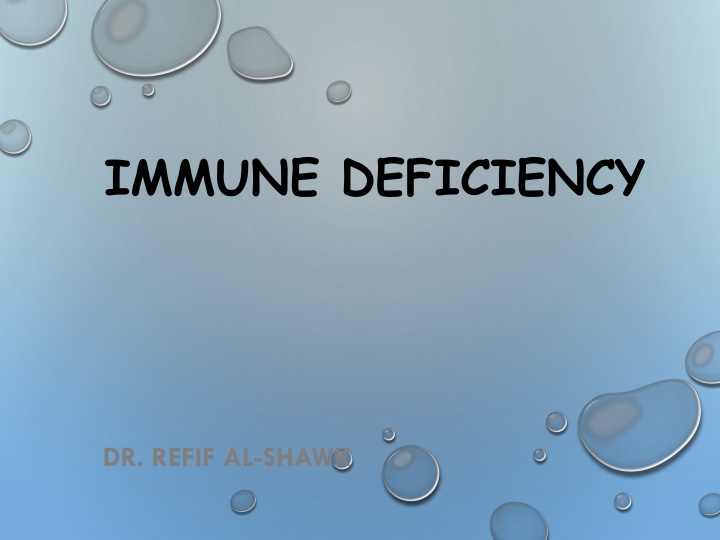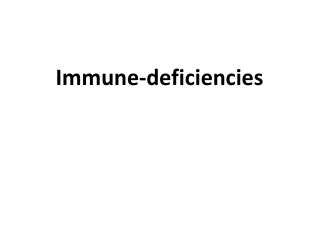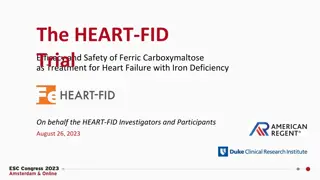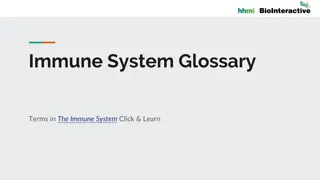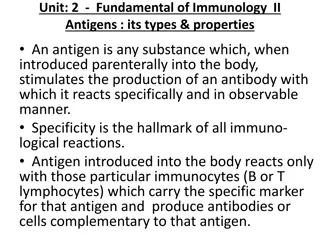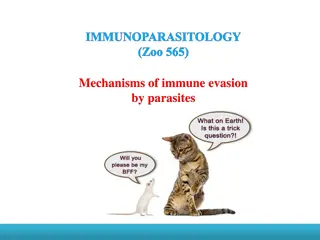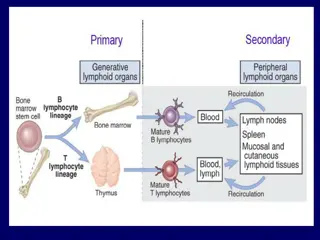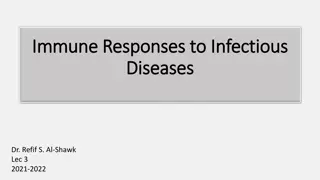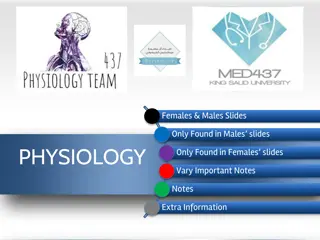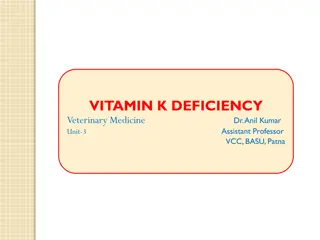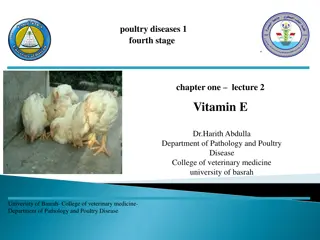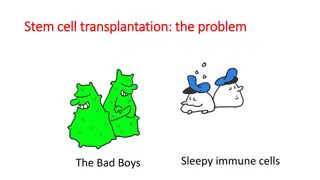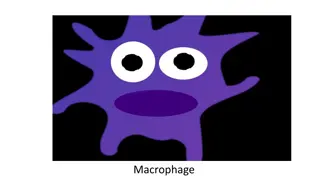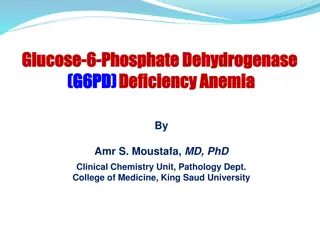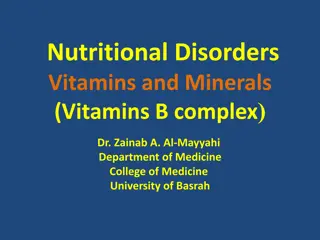IMMUNE DEFICIENCY
Immune deficiency diseases result from genetic or acquired factors affecting the immune system. These disorders can impact cell numbers, functions, and overall immune response, leading to recurrent infections and other health challenges. Primary and secondary forms of immune deficiencies can arise, each with distinct causes and mechanisms. Recognizing the characteristics and subtypes of these diseases is crucial for proper diagnosis and management.
Download Presentation

Please find below an Image/Link to download the presentation.
The content on the website is provided AS IS for your information and personal use only. It may not be sold, licensed, or shared on other websites without obtaining consent from the author.If you encounter any issues during the download, it is possible that the publisher has removed the file from their server.
You are allowed to download the files provided on this website for personal or commercial use, subject to the condition that they are used lawfully. All files are the property of their respective owners.
The content on the website is provided AS IS for your information and personal use only. It may not be sold, licensed, or shared on other websites without obtaining consent from the author.
E N D
Presentation Transcript
IMMUNE DEFICIENCY DR. REFIF AL-SHAWK
IMMUNODEFICIENCY DISEASE: Caused by defect in various components of immune system and results from a genetic or developmental defect or acquired factors in the immune system
IMMUNE DEFICIENCY OCCUR IN TWO DIFFERENT WAYS PRIMARY I.D. -USUALLY GENETIC, CONGENITAL SECONDARY I.D. -ACQUIRED (INFECTION ,THERAPEUTIC TREATMENTS, CANCER & MALNUTRITION)
MECHANISMS OF IMMUNODEFICIENCY LOSS OR REDUCTION OF: CELL TYPE CELL NUMBERS CELL FUNCTION
LOSS OF CELL FUNCTION Receptors Cell signaling Cytokine production Ig production Co-stimulation impairment Intracellular killing Extravasation impairment
Characteristics seen in many immune deficiency diseases include the following: Recurrent or chronic infections Inability to clear infectious agents after standard antibiotic therapy Unusual infectious agents
PRIMARY IMMUNODEFICIENCY Myeloid lineage Congenital agranulocytosis Leukocyte-adhesion deficiency Chediak-higashi syndrome Lymphoid lineage Severe combined immunodeficiency (SCID) B cells Agammaglobulinemia Hypogammaglobulinemia Specific Ig Deficiencies T cells DiGeorge Syndrome Wiskott Aldrich Syndrome Complement or its Regulation Hereditary angoedema
DEFECT IN PHAGOCYTIC CELLS (MYELOID): (phagocytes, neutrophils) Defects are significant because of their key role in innate and adaptive I.R. affect both ability to kill microb ( Chronic granulomatous disease, Chediak-higashi syndrome ) interactions with other cell (Leukocyte adhesion defect 1)
DEFECTS IN MYELOID LINEAGE Progenitor Progenitor Progenitor Progenitor
Chronic Granulomatous Disease (CGD) Defect in enzymes and microcidal molecules (NADPH oxidase; failure to generate superoxide anion & other O2 radicals) So the microorganisms will be ingested but not killed Symptoms : recurrent infections with catalase- positive bacteria and fungi specially Staphylococcus aureus
Chediak- Higashi Syndrome Normal levels of these enzymes(digestive) Defect in organelle membrane which inhibits normal fusion of lysosomes Fail to destroy ingested microbes Symptoms : Recurrent infection with bacteria (chemotactic and degranulation defects, absent NK activity, partial albinism)
Leukocyte Adhesion Defect 1 ( LAD-1) Absence of CD 18 common eta chain of leukocyte integrin, and become un able to migrate Symptoms : Recurrent and chronic infection , fail to form pus
LYMPHOID LINEAGE B cells X-linked (Bruton) Agammaglobulinemia X-linked hyper-IgM syndrome Specific Ig Deficiencies (Selective IgA deficiency) Common variable immunodeficiency T cells DiGeorge Syndrome Wiskott Aldrich Syndrom Bare Lymphocyte syndrome/ MHC II deficiency MHC I deficiency Complete functional B and T cell deficiency Sever combined immunodeficiency (SCID)
Defect In Humoral Immunity These B-cell defects are responsible for the majority (more than 80%) of human immunodeficiency diseases Patients with common defects in B-cell function have pyogenic infection : pneumania otitis media sinusitis
DEFECTS IN B-CELL FUNCTION DUE TO Isotype switching dose not occur Early B cell maturation blocked Terminal differentiati on of B cell blocked T-cell to B-cell is defective
DEFECTS IN B CELL DEVELOPMENT Progenitor Progenitor Progenitor Progenitor
Early B Cell Maturation Fails In X-linked (Bruton) Agammaglobulinemia Genetic disease that only affects males which results in few or no B cells in their blood or lymphoid tissue The genetic defect in gene Bruton tyrosine kinase (BTK) an enzyme that is critical to early differentiation of B-cells into plasma cells which ultimately are responsible for producing immunoglobins Because of abnormally low immunoglobin levels, the patient is susceptible to certain infections (encapsulated bact.) such as: Meningitis Recurrent ear infections Chronic sinus/upper respiratory infections Treatment : monthly gammaglobulin replacement, antibiotics
Terminal Differentiation Of B Cells Fails In Selective IgA Deficiency Most common immunoglobulin deficiency affecting 1 to 2 per thousand individuals Main physical characteristic is a severe reduction in the levels of serum and secretory IgA that results from the inability of mature B cells to transform into IgA secreting plasma cells Usually there are normal level of other isotypes Persons with this disease tend to be affected with: Chronic upper respiratory infections Chronic GI infections Increased incidence of allergic diseases such as asthma Treatment : antibiotics, not immunoglobulins
Isotype Switching Dose Not Occur.. Hyper-Igm (HIgM) Defect in gene encoding the CD40 Ligand on T cell which is important in the costimulatory signal required for class switching from IgM to IgG, IgA and IgE (The B-cell response to T-independent antigens only) Symptoms : High serum titers of IgM without other isotypes , normal B & T cell Although this form of immunodeficiency results in alterations in antibody production and presents with symptoms similar to HIM variants, it is classified as a CID Increased susceptibility to extracellularbacteria & opportunists Treatment : antibiotics and gammaglobulins
CD40 LIGAND B T h CD40 ligand Cytokines - IL-4, 5, 6
Examples for humoral immunity defects. Disease Molecular defect Def of tyrosine kinase so blocks B- cell maturation Symptoms/signs Treatment Bruton X- linked hypogamma gloulinemia 1.Low Ig of all classes. 2. No circulating B cell. 3.B-cell maturation stopped at pre-B stage. 4. Normal CMI. 1.Monthly gammaglobulin replacement. 2.Antibiotic. X-linked hyper-IgM syndrome Def of CD40L on activated T cell Antibiotic & gammaglobulin . 1.Higher serum titer of IgM only. 2. Normal B & T cell number. 3. Susceptibility to EC bacteria & opportunists.
Disease Molecular defect Symptoms/signs Treatment Selective IgA deficiency Deficienc y of IgA Repeated sinopulmonary & GIT infections. 1.onset in late teens. 2.B cell present in peripheral blood. 3.Ig level with time. 4.increase autoimmunity & atopy Antibiotic, not Ig. Common variable immunodef Unknown Antibiotics decrease
T- CELL DEFICIENCY Caused by problem with T lymphocytes (both CD4+ helper cells and CD8+ cytotoxic killer cells) Patient s have more severe symptoms than with humoral immunodeficiency
DEFECT IN T-CELL Defect in cells that are critical to the development or activation of T cell (APC) Combined partial B & T cell defect Defects in thymic development (abnormal embryonic changes) Reduced MHC I molecules Reduced MHC II molecules Prevent thymic education of T cell Decrease No. of functional CD8+ & NK Decrease No. of functional CD4+
DEFECT IN T CELL DEVELOPMENT Progenitor Progenitor Progenitor Progenitor
DEFECTS IN THYMIC DEVELOPMENT DIGEORGE'S SYNDROME: It is the most understood T-cell immunodeficienc Also known as congenital thymic aplasia/hypoplasia Associated with hypoparathyroidism, congenital heart disease, fish shaped mouth. Defects results from abnormal development of fetus during 6th-10th week of gestation when parathyroid, thymus, lips, ears and aortic arch are being formed
MHC DEFICIENCY CLASS II DEFICIENCY (BARE LYMPHOCYTES SYNDROME II): Due to defect in the MHC class II transactivator protein gene, which results in a lack of class-II MHC molecule on APC. Patients have fewer CD4 cells , immunoglobulin levels decreased owing to defective T-cell help Increased susceptibility to infection
MHC DEFICIENCY CLASS I DEFICIENCY (BARE LYMPHOCYTES SYNDROME I OR TAP- 1 OR 2 DEFICIENCY): There are also individuals who have a defect in their transport associated protein (TAP) gene and hence do not express the class-I MHC molecules and consequently are deficient in CD8+ T cells , CD4+ normal recurrent viral infection , normal DTH, normal Ab production
COMBIEND PARTIAL B- AND T-CELL DEFICIENCY ATAXIA-TELANGIECTASIA: Defect in kinase involved in cell cycle Associated with a lack of coordination of movement (ataxis) and dilation of small blood vessels of the facial area (telangiectasis). T-cells and their functions are reduced to various degrees. B cell numbers and IgM concentrations are normal to low.
DEFECTS IN LYMPHOID LINEAGE Progenitor Progenitor Progenitor Progenitor
COMPLETE FUNCTIONAL B- AND T- CELL DEFICIENCY SEVERE COMBINED IMMUNODEFICENCY (SCID) In about 50% of SCID patients the immunodeficiency is x-linked whereas in the other half the deficiency is autosomal. They are both characterized by an absence of T cell and B cell immunity and absence (or very low numbers) of circulating T and B lymphocytes. Patients with SCID are susceptible to a variety of bacterial, viral, mycotic and protozoan infections.
SEVERE COMBINED IMMUNODEFICENCY (SCID) 1. The x-linked SCID is due to a defect in gamma-chain of IL-2 also shared by IL-4, -7, -11 and 15, all involved in lymphocyte proliferation and/or differentiation.(more common in male) 2. the autosomal SCIDs arise primarily from defects in adenosine deaminase(ADA) or purine nucleoside phosphorylase(PNP) genes which results is accumulation of dATP or dGTP, respectively, and cause toxicity to lymphoid stem cells and apoptosis(T,B &NK)
SEVERE COMBINED IMMUNODEFICENCY (SCID) 3. Mutations in the recombinase activating genesRAG-1 & RAG-2 gene deficiency which are absolutely required for cleaving dsDNA befor recombination of DNA to form the Ig genes encoding T cell receptors leading to undeveloped B & T cell 4. & genes encoding proteins involved in the DNA excision- repair pathways employed during gene rearrangement (e.g., Artemis) can also lead to SCID
5. In reticular dysgenesis (RD), the initial stages of hematopoietic cell development are blocked by defects in the adenylate kinase 2 gene (AK2), favoring apoptosis of myeloid and lymphoid precursors and resulting in severe reductions in circulating leukocytes
screening test for SCID develop the standard blood samples collected from neonates via heel or finger pricks Rapid polymerase chain reaction (PCR)-based assay looks for evidence of gene recombination as in excised DNA from the TCR or BCR locus, called T-cell receptor excision circles (TRECs) and -deleting recombination excision circles (KRECs). In 2010, recommendations to screen every newborn for SCID were approved.
B and T-cell deficiency divided into these categories: A. Selective T-cell deficiency: Disease Defect Clinical manifestation Depression of T cell number with absence of responses. DiGeorge syndrome Thymic aplasia 1.CD8+ T cell def. 2.CD4+ T cell normal. 3. Recurrent viral infection. 4.Normal Ab formation. MHC class I deficiency Failure of TAP 1 molecule to transport peptide to endoplasmic reticulum Defects in transcription factors. 1.def of CD4+ T cell. 2. Hypogammagloulinemia. 3.Clinically as SCID. MHC class II def(Bare lymphocyte syndrome)
B. COMBINED PARTIAL B AND T-CELL DEFICIENCY: Ataxia telangiectasia Defect in kinase involved in the cell cycle. 1. gait abnormality. 2. Telangectasia (capillary distortion in the eye). 3.def of IgA & IgE production. C. Complete functional B and T cell deficiency: Sever combined ID(SCID). Defects in common chain of IL-2 receptor. 1. Opportunistic (fungal) infection. 2. Low level of circulating lymphocyte.
DISORDERS OF COMPLEMENT SYSTEM: Complement abnormalities also lead to increased susceptibility to infections. There are genetic deficiencies of various components of complement system, which lead to increased infections. The most serious among these is the C3 deficiency which may arise from low C3 synthesis or deficiency in factor I or factor H.
DISORDERS OF COMPLEMENT SYSTEM DUE TO Classical pathway Both pathway Deficiencies in complement regulatory proteins
DEFECT IN CLASSICAL PATHWAY Deficiencies of the classical pathway C1q, C1r, C1s, C4, or C2 Result in a propensity to develop immune complex diseases such as SLE because it required for the dissolution of immune complexes Increasing the risk of immune complex diseases SLE and increased infections with pyogenic bacteria
DEFICIENCY IN BOTH PATHWAYS Deficiency in C3 result in recurrent bacterial infection (pyogenic) indicating the importing role of C3 in opsonization of pyogenic bacteria Deficiency of the terminal components C5-C8 result in remarkable susceptibility to infection with meningococcal & gonoccocal infections
DEFICIENCIES IN COMPLEMENT REGULATORY PROTEINS The most important deficiency of the complement system is C1 inhibitor which is responsible for dissociation of activated C1 by binding to C1r2 C1s2 Deficiency result in Hereditary angioedema (HAE) Patients have recurrent Episodes of swelling at mucosal surfaces
4. DEFECTS OF COMPLEMENT. Deficiencies of complement or its regulation as in these cases: Components Deficiency Signs/diagnosis Classic pathway 1.Marked complex disease. 2.Increased infection with pyogenic bacteria. C1q,C1r,C1s, C4,C2 increase in immune Both pathways 1.Recurrent bacterial infection. 2.Immune complex disease. C3 C5,C6,C7,C8 Recurrent meningococcal & gonococcal infections. Def of regulatory proteins. 1.Overuse of C1,C4 or C2. 2.Edema at mucosal surfaces. C1-INH (hereditary angioedema)
Type Of Infection Helps Predict The Type Of Immunodeficiency B lymphocyte - pyogenic bacteria - lungs T lymphocyte - viruses, fungi, mycobacteria Complement - meningococcus - CNS Phagocyte - staphylococcus - skin
